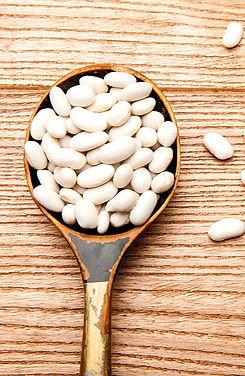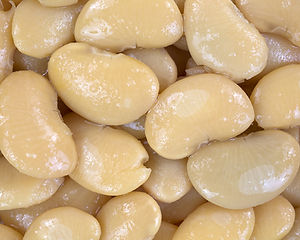
11. Beans & Seeds
Easy peasy!
Beans & Seeds are important ingredients in the Asian kitchen, they are very versatile and form the basic ingredient of many dishes. Filled with nutrients they are also growing more and more popular as alternative to meat or fish.
In this chapter 11 we explain Beans, Peas, Lentils and Seeds and all the different varieties in the H&S assortment...
BEANS
Beans are an important basic ingredient in the Asian and African kitchen. Beans are very nutritious food, high in proteins and fiber, and an excellent substitute for meat. You can find them precooked in tins. These beans are ready to use, they just need to be drained. Dried beans need to be soaked in water for a couple of hours, often even overnight, before cooking. There are many different kinds of beans, popular for different target groups/ethnicities and used in many different ways, from savory to sweet dishes or as raw material for all kind of processed food.

MUNG BEANS
Green Mung Beans are available whole and split. Split Mung Beans can be peeled or unpeeled, and are also referred to as lentils (Mung Dal/Moong Dal Chilka). They may be used in stews, pastes and desserts in many different ways in mainly Asian & Indian kitchen. Whole Mung Beans, if suitable for sprouting, may be used for making your own bean sprouts. See an overview about different uses and dishes here

RED BEANS/ ADZUKI
Red Beans, also known as Adzuki beans or as Red Mung Beans, are used for the production of red bean paste (or "Anko" in Japanese) in Chinese, Japanese, and Thai cuisine. It is a popular ingredient for desserts. H&S offers e.g. Red bean ice bars (Madame Wong) or Mochi’s with red bean paste (Yuki & Love). Monika (brand from the Philippines) Red Beans in glass jar are in heavy syrup. There is also a black variant of Adzuki Beans, however the red variant is more common. Do not confuse these beans with Red Kidney beans, Kidney Beans are bigger and kidney shaped.
BLACK BEANS
There are different kinds of Black Beans. You have the regular Black Beans (Phaseolus vulgaris) which are especially popular in Latin-American kitchen. Black Beans are a good addition to Burritos and delicious in salads.
Also Black Soy Beans can be referred to as Black Beans. Fermented and salted (Douchi) are very popular in Asia and used for e.g. the famous Black Bean Sauce, stews, in rice or porridge dishes, but also desserts like Black Beans in coconut sauce. In Indian kitchen Black Beans are mainly used in vegetarian stews and dal dishes.

SOY BEANS
Soy Beans are indispensable in Asian cuisine. In China, Japan, and Korea, Soy Bean and Soy Bean products are a common part of the diet. They can be used to make Soy Milk. Finely grinded Soy Beans can be processed into Tofu or Tempeh. You will get Soy Sauce through natural culturing and a controlled fermentation process. You may use boiled Soy Beans for your Tofu salads. Different Soy Bean Pastes (e.g. Japanese miso, Korean Doenjang or Vietnamese Tuong) are used as seasonings. Whole dried Soy Beans are used to cook a variety of dishes, they find their use in soup or as a savory dish. Roasted in the oven you can make ‘soy nuts’ and enjoy them as snack.
By the way, ‘Edamame’ are young, green soy beans, you can usually find them frozen.


BLACK EYE BEANS
Black Eye Beans are White Beans with a black dot. The beans taste a bit like peas, and are used all over the world for different kinds of dishes. They are used extensively in African dishes such as Accara (crunchy fried balls) or Moi-Moi (Nigerian balls made of beans, fish, and onions) or other African porridges.
In India they are eaten on New Year's Day as a symbol of prosperity and happiness. They might also be used in vegetarian curries and pilaf dishes (Lubia Pilav) or served a snack with Yogurt Raita and Roti.
Check this link for more culinary uses worldwide.

WHITE BEANS
White Beans (Phaseolus Vulgaris) are not only popular in African countries but also in Asia and in Western countries because they are extremely tasteful. They are ideal for preparing all kinds of stews with meat and other vegetables, soups in cold salads and African specialties such as Taymiyya (fried Egyptian bean balls) or Tajine dishes.
CRANBERRY/
ROSECOCO BEAN
Cranberry Beans have many different names. You can also find them as Rosecoco Bean, Quail Bean, Roman Bean, Saluggia Bean and Gadhra Bean. And this are only the English names gathered for that specific bean! The Borlotti Bean is a variety of the Canberry Bean bred in Italy to have a thicker skin.
Cranberry Beans are also a variety of the common bean (Phaeseolus Vulgaris). They are oval, white, red(brown)-speckled. These beans perfectly absorb the flavour of the other ingredients, and are delicious in soups or curries. They might be used for preparation of African specialties such as Chakalaka (South African herb sauce) and Kaba-Kaba (stew with beans).


PEAS
The pea is an edible legume. You can find peas dried, in tin or frozen. Fresh peas are less common as they have short shelf life and loose flavour quickly. H&S sells Split Peas and a variety of Chickpeas, dried and in tin. Unlike Beans (Split) Peas do not need presoaking. However, you can shorten the cooking time if you do so. Dried Chickpeas do need te be pre-soaked. Like other pulses Peas have excellent nutritional values, high in fiber & protein.

SPLIT PEAS
H&S offers dried split peas. Dried Split Peas and Lentils look very much alike. Both of them are legumes, but Split Peas and Lentils come from different varieties of legumes.
There are Green and Yellow Split Peas. Green Split Peas are sweeter and less starchy then Yellow Split Peas. The use of Split Peas is quite similar to Lentils. You can use dried Split Peas to make soup, e.g. the famous Dutch ‘Snert’/‘Erwtensoep’ (is made of Green Split Peas) or Moroccan ‘Bissara Tamaraqt’. In India Split Peas may be used in curries such as Matar Daal, but also in stews, purees or as filling for Samosas. Furthermore Split Peas can be found in several Indian and Caribbean dishes.

CHICKPEAS
The bestselling peas at H&S are Chickpeas, also known as ‘Gram’ and as Peas of the Garbanzo/Garbanzo Beans. Note that Gramflower is made from dried and grounded Chickpeas. Technically Chickpeas are not closely related to the ‘real’ pea (Pisum Sativum), however we call them Chickpeas. Chickpeas are important in Indian and Middle Eastern kitchen, where they are used in salads, stews, curries (like Chana Masala (hot Chickpea Curry) or Chana Aloo (curry dish of potatoes and peas)), to make your own Hummus or Falafel.
There are yellow and brown Chickpeas, the use is quite similar. Yellow chickpeas are somewhat mealier and cook faster while brown Chickpeas are rougher and have higher fibre content.
LENTILS
Just like Beans Lentils have excellent nutritional values, high in fiber & protein. Advantage of Lentils compared to Beans is that they do not need presoaking. That is why Lentils are commonly sold dried. Compared to Beans Lentils contain more fiber and less carbohydrates. Check this Dutch article for more information about the differences between beans & lentils.
Lentils are often referred to as ‘Dal’, ‘Daal’or ‘Dahl’. That’s Hindi en stands for dried and split pulses, and can refer to Lentils, Peas or Beans. In comparison with dried beans or Chickpeas Lentils do usually not need pre-soaking, so they are more convenient in use.
Also you will find ‘Dal’ accompanied by ‘Chilka’. Chilka stands for ‘skin’, meaning the pulse in question is not peeled.
Lentils are used world wide in many different ways. They might be used in stews, combined with chicken or pork, in salads etc.
In Indian subcontinent, Lentils are a staple. Split Lentils (often with their hulls removed) are often cooked into a thick Curry that is usually eaten with Rice or Rotis. Lentils are also used as stuffing in Parathas and used for breakfast or snack dishes, as well as many regional varieties of sweets . Rice and some lentils have similar cooking time, so they are often combined and this is called a Mujaddara or Mejadra dish.
RED/GREEN/BROWN
There are many varieties for Lentils. However, the most important are Red, Green & Brown Lentils.
Brown lentils are suited to use for soup.
Green Lentils and (black) Beluga Lentils stay firm after cooking, so they may be used in e.g. salads.
Red Lentils turn yellowish-golden and loose their shape after cooking.



URID LENTILS
Urid lentils, also called Urad Bean or Black Gram, are a relative to the Mung Bean. Urid Beans are black, but do not confuse them with Black Beans. If the Urad Bean is split the color is dark/brown-white. If the Urad Beans is split and peeled the colour is white, and also referred to as ‘cleaned Urid Lentils’.

SEEDS
Next to Beans, Peas and Lentils (=also seeds) H&S also offers some other kinds of seeds which are used for cooking, preparing food or as topping to make a dish extra attractive.
SESAME SEEDS
There are White and Black Sesame Seeds. They are an important ingredient in the Asian kitchen, used for flavour and decoration. The taste is quite similar. For many dishes the Sesame Seeds are roasted in a dry pan to enhance flavour and odour. Use them to decorate your noodles, salads, chicken, fish, sushi etc. Sesame Seeds are also for baking, e.g. for bread, cookies & pastry.
Sesame Paste, Tahin or Tahini is also made from sesame seeds.
Note that Sesame is an allergene and can trigger allergic reactions.

LOTUS SEEDS/NUTS
Lotus Seeds (or Lotus Nuts) are used for Asian dishes, desserts and in traditional medicine. The seeds are usually sold hulled and dried, but H&S also offers boiled Lotus Nuts in tin. Lotus Nuts may be used for the filling of Chinese Moon cakes
and for the preparation of sweet soups and Congee (rice pudding). The flavour of the Lotus Nuts is similar to the taste of almonds.


BASIL SEEDS
Sweet Basil Seeds are the seeds of Thai Basil (Sweet/Holy/Melon). When combined with water they turn into a kind of spawn, transparant jelly bulbs with a black dot in the centre. They taste a bit like Anise. Basil Seeds can be used in drinks and desserts, they float which gives a nice effect.





















